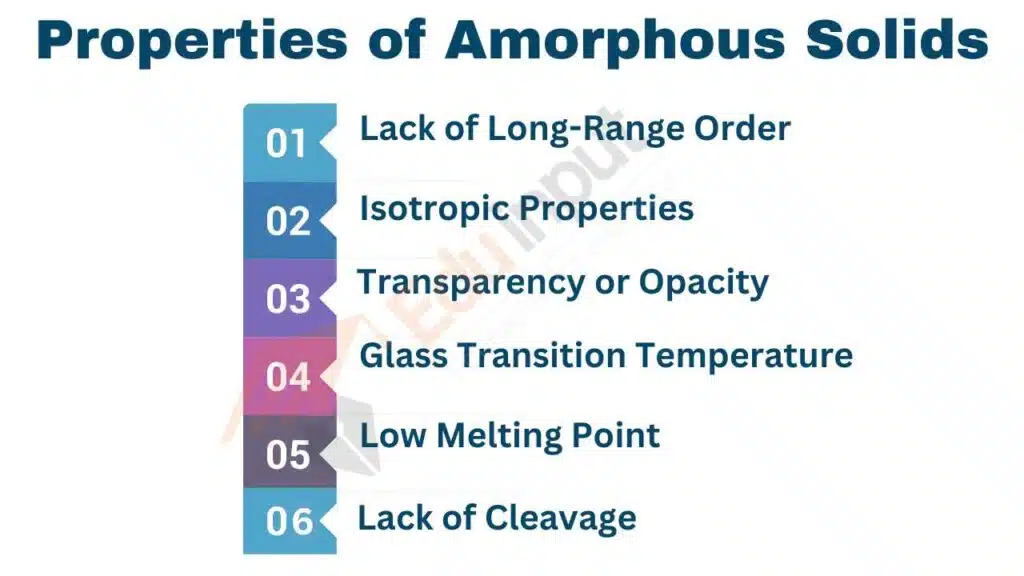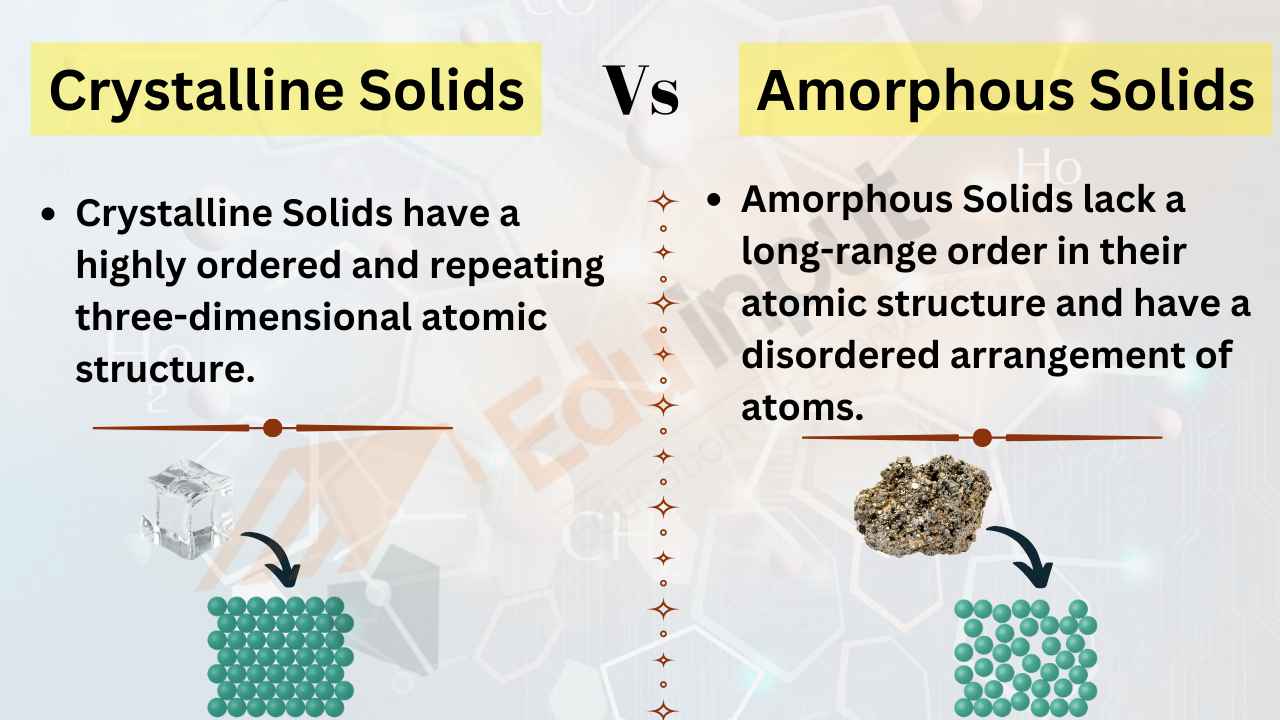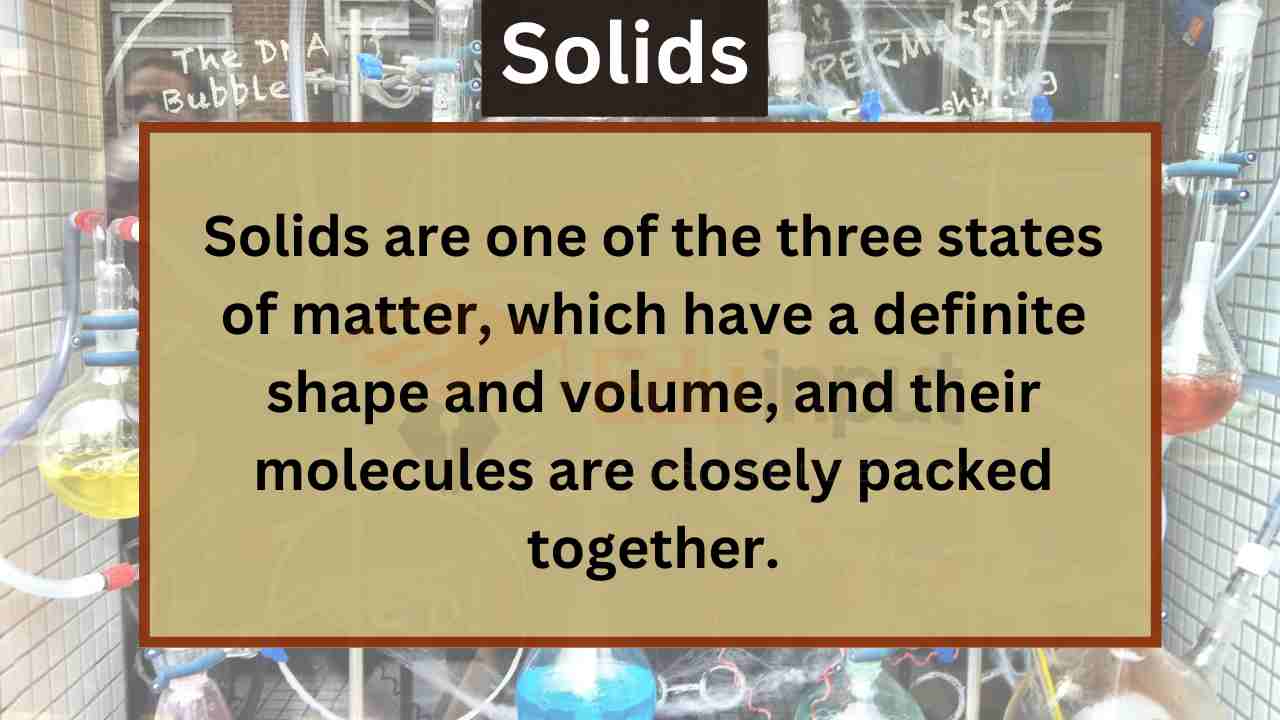Amorphous Solids – Meaning, Definition, Properties, and Structure
What is Meaning of Amorphous?
Amorphous means something that does not have a clear or regular shape or structure. It is used in different fields to describe objects or substances that lack a fixed, organized form:
- In general: Something shapeless or formless.
- In chemistry: A solid that does not have a regular, repeating pattern of atoms (like glass or gels).
- In biology: A structure in a living organism that does not have a distinct shape or clear organization (like amorphous tissues).
It comes from the Greek word “amorphos,” meaning “without shape.
What Are Amorphous Solids?
Amorphous solids, also known as non-crystalline solids, are solids that lack the long-range order found in crystalline solids. Unlike crystalline solids, which have a regular and repeating pattern of atoms or molecules, amorphous solids exhibit a disordered and random arrangement of their particles.

This unique structure makes them isotropic, meaning their properties are the same in all directions. Common examples of amorphous solids include glass, rubber, plastic, wax, and asphalt.
In this article, you’ll learn:
- The definition of amorphous solids.
- Their properties and how they differ from crystalline solids.
- Structure of Amorphous solids
What Is Definition of Amorphous Solid?
An amorphous solid is a type of solid that lacks a well-defined crystalline lattice. Instead of having a regular repeating structure, the atoms or molecules in an amorphous solid are arranged randomly.
Key Characteristics
- No long-range order.
- Random particle orientation.
- Isotropic behavior (uniform properties in all directions).
For example
- Glass forms when molten silica cools quickly, preventing the formation of a crystal lattice.
- Rubber and plastic are polymers with disordered structures.
Structure of Amorphous Solids
Amorphous solids do not have long-range order. This means the atoms, ions, or molecules are arranged randomly, unlike the highly ordered structure seen in crystalline solids. In crystalline solids, the repeating pattern of particles forms a regular structure, but in amorphous solids, the lack of this regularity results in different physical properties.
- Random Atomic Arrangement: The random arrangement of particles results in unique material characteristics. These solids are typically more flexible than crystalline solids because their atoms are not locked into a fixed pattern.
- Lack of Crystalline Lattice: The structure of amorphous solids does not have a repeating lattice pattern, which means they do not have sharp and well-defined boundaries like crystalline solids.
Properties of Amorphous Solids
Amorphous solids are known for their distinct properties from crystalline solids. Here are their main properties:

1. Lack of Long-Range Order
Amorphous solids do not have a repeating, ordered arrangement of particles. This lack of long-range order contributes to several unique properties:
- Flexibility in Shape: Amorphous solids can bend or deform more easily than crystalline solids due to their disordered structure.
- Varying Transparency: Some amorphous solids, like glass, are transparent, while others, like rubber, are opaque. This property depends on how the material’s particles scatter light.
2. Isotropic Properties
Isotropic means that a material’s properties are uniform in all directions. Amorphous solids show isotropic behavior because of their random atomic arrangement:
- Consistent Strength: The strength of an amorphous solid is the same in all directions.
- Uniform Refractive Index: Light passing through amorphous materials, like glass, behaves the same no matter the direction.
- Thermal Conductivity: The ability to conduct heat is the same in all directions within the material.
This uniformity makes amorphous solids predictable in performance, which is why glass and rubber are used in so many applications.
3. Low Melting Point?
Unlike crystalline solids, which have a defined melting point, amorphous solids soften gradually. This is because their atoms are not in a regular arrangement, making it hard for the material to melt at a specific temperature. Instead, they experience:
- Gradual Softening: As heat is applied, the material transitions from solid to liquid more slowly, unlike crystalline solids, which melt sharply at a fixed temperature.
4. Glass Transition Temperature (Tg)
The glass transition temperature (Tg) is a key feature of amorphous solids, especially polymers like rubber and plastic. This is the temperature at which the material changes from a hard, brittle state to a softer, more flexible state. For example:
- Glass: Glass has a Tg around 500°C, meaning it becomes softer and more flexible at higher temperatures.
- Plastic: The Tg for plastic varies depending on its chemical structure. Plastics can be engineered to have a wide range of transition temperatures, making them useful for various applications.
5. No Cleavage Planes
In crystalline solids, the atoms are arranged in a regular pattern, which allows them to break along defined planes called cleavage planes. Amorphous solids, however, do not have this regular pattern, so:
- Irregular Fracture: When amorphous solids break, they do so unpredictably, often creating jagged edges. This is typical of materials like glass, which fractures irregularly when hit.
6. How Does Transparency and Opacity Differ in Amorphous Solids?
Amorphous solids can range from transparent to opaque, depending on how their particles interact with light. For example:
- Transparent Materials: Glass, a common amorphous solid, is transparent because its atoms allow light to pass through with little scattering.
- Opaque Materials: Rubber and asphalt are opaque because their structure scatters or absorbs light, preventing it from passing through.
7. High Elasticity
Some types of amorphous solids, especially rubber and certain plastics, are highly elastic. This means they can stretch and deform under stress but return to their original shape when the stress is removed. This elasticity is a result of the disordered structure of polymers:
Rubber: Rubber is a good example of an amorphous solid with high elasticity. It can stretch and return to its original shape, making it ideal for applications like tires, seals, and elastic bands.
FAQs
How are amorphous solids different from crystalline solids?
Amorphous solids lack a well-defined crystalline lattice structure and exhibit isotropic behavior. Crystalline solids, on the other hand, have a well-defined repeating pattern of atoms or molecules and exhibit anisotropic behavior.
Can amorphous solids be transformed into crystalline solids?
Yes, some amorphous solids can be transformed into crystalline solids through a process called annealing. This involves heating the material to a high temperature and then cooling it slowly to allow the atoms or molecules to rearrange into a crystalline lattice structure.
What is the meaning of amorphous in chemistry?
Amorphous means “without form” and refers to substances with no regular atomic or molecular arrangement.
Can amorphous solids become crystalline?
Yes, through annealing, where the material is slowly heated and cooled, allowing atoms to align in a crystal lattice.
Why are amorphous solids isotropic?
Their random atomic arrangement ensures that physical properties remain consistent in all directions.







Leave a Reply